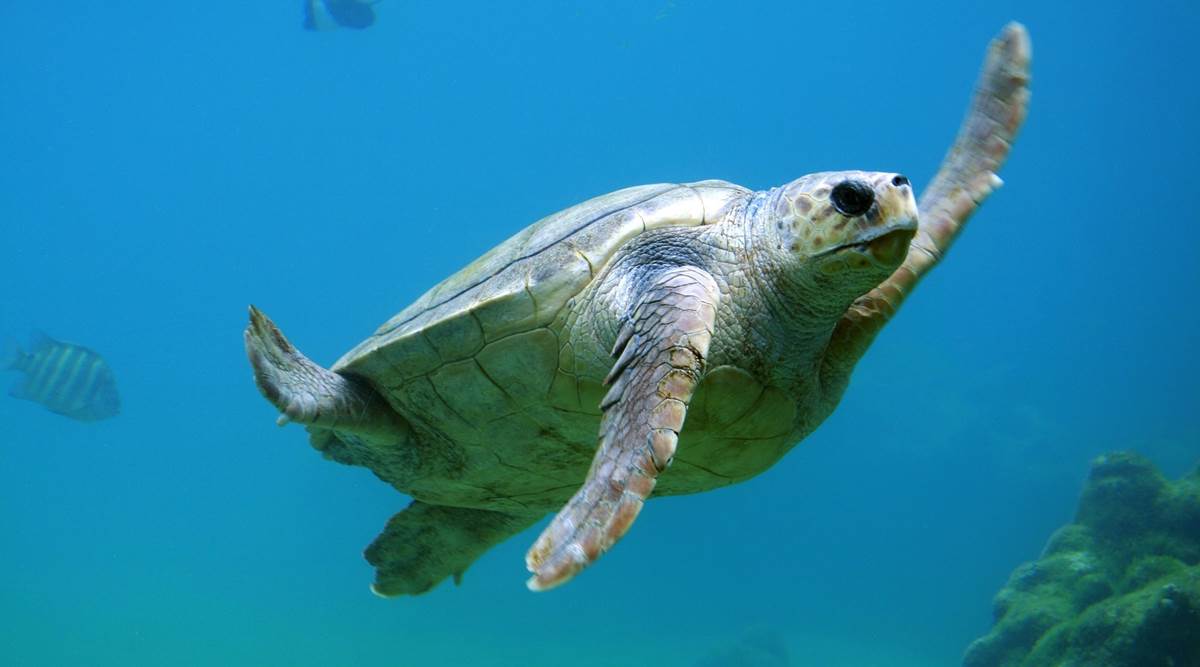A science teacher explains: Why do sea turtles, whales, king penguins swim in circles?
Moving round and round in the same place enables the animal to capture the incredibly tiny variations in magnetic field strength and guides them to the precise location they need to get to.

By Rachna Arora
Sea turtles are among the world’s oldest groups of reptilians. They are present in all but Earth’s coldest oceans and have been around since the late Jurassic period dating back to 120 million years.
Sea turtles are known to have geo-magnetic abilities attributed to the presence of magnetite, an ore of iron in their brain. This equips them with their very own internal GPS as evident from their remarkable migratory abilities. Baby sea turtles imprint a unique magnetic signature of the beaches where they hatch. This magnetic map guides them back to the same beaches several years later to lay their own eggs while travelling thousands of kilometers from their feeding grounds to their nesting beach.
As the sea turtles make their journey from feeding to nesting grounds and back, they have been observed to move round and round in circles or spirals, at nearly the same speed, not only in the course of their journey but also close to their destination. This observation bewildered scientists for ages. Research has now indicated that this baffling behaviour is actually a mode of navigation employed by the sea turtles, which enables them to study magnetic fields and thus attune their position in the open sea with powerful currents and very little light to circumnavigate (as they do not have the luxury of using SONAR as man does). This ability is referred to as magnetoreception.
ALSO READ |A science teacher explains: A shooting star has nothing to do with a star
Moving round and round in the same place enables the animal to capture the incredibly tiny variations in magnetic field strength and guides them to the precise location they need to get to. Besides, this might also enable the turtles to check a variety of location clues including sound and chemicals, which aid the navigation process.
Many organisms including some bacteria, fruit flies, migratory birds, homing pigeons, hens and even some rats use this sixth sense for navigation or fleeing to safer environments. In fact, man’s best friend, dogs too use their inbuilt compass, to read the magnetic field of the earth and find their way home if lost. Although how magnetoreception works is yet to be deciphered.
We have many marine species which swim round and round in a loop or a spiral. The exotic scene of a shark, menacingly encircling its prey in the Steven Spielberg classic, Jaws, corroborates this. It is relatively easy to comprehend the circular motion of sharks. They do so for food. In effect, sharks have electroreceptors on their head which can detect the weakest of electrical signals, like the faintest heartbeat of a frightened fish. As the sharks move in circles they are able to pinpoint the location and attack their prey with speed, agility and precision.
ALSO READ |A Science Teacher Explains: How do some animals see better at night?
Another ocean predator, the humpback whales, who hunt in packs are characterised by the bubble net feeding behaviour. The lead whale dives down, then spirals upwards blowing air out of its blowhole creating a cylinder of bubbles. The remaining animals cage the school of fish into this curtain of fizz, thus exhibiting an ingenious way of fishing and displaying an extraordinary level of intelligence and cooperation.
Also, some species of whales who deep dive, ascend in spirals as this not only reduces the odds of any injury if they move up at a high speed but also ensures that they regroup with their companions and do not become an easy prey for a bigger fish.
The emperor penguins are also known to swim in circles near the surface of water. They do so to either preen their feathers, or to exercise their muscles and get their blood flowing and thereby warm up in the Antarctic weather.
Thus circling seen in marine organisms probably serves many purposes, which we are just beginning to understand. While search for food and safety are educated guesses, there might be other reasons too related to environment conditions or even for courtship.
ALSO READ |A science teacher explains: Are cockroaches resistant to nuclear radiation?
Man has always emulated nature and been inspired by it. This is evident in the circling behaviour we have adopted, whether it is submarines moving in circles to collect the geomagnetic data or us moving in circles looking for some landmarks if lost in the woods.
The field of research dedicated to understanding the mystery of the circle or spiral motion of marine creatures for sure is very intriguing. The frontier is not just to understand the reason behind the circling behavior but also to comprehend how different species have developed similar behaviour.
(The writer is PGT- Physics at Shiv Nadar School, Noida)
Source: Read Full Article


